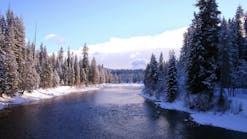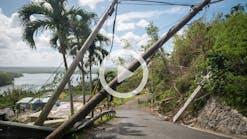Julie Etra’s approach to the erosion control work her company does is simple to describe. It isn’t always easy to accomplish, though.
“You shouldn’t know we were ever there. [The work is] so good that it matches what was there before,” explains Etra.
Making a newly established section of ground match an existing part of a property or roadside takes skill and knowledge. Etra has both, and enthusiasm for her work. In the last couple of years she has branched into designing and evaluating erosion control projects through her company, Western Botanical Services, in Reno, NV.
One of Etra’s challenging projects was controlling erosion on the steep slopes of the Church of Latter Day Saints (LDS) in Reno. The church needed to stabilize the slopes and control stormwater runoff. The project, which covered about an acre and a half, began in August 2014 and was finished in October.
“The site faces south and it’s very windy, up on a hill. The Mormons usually put their temples in prominent spaces [like this one],” says Etra.
“The soils are really crummy. They are diatomaceous earth, so there are a limited number of plant species that will grow there,” she adds.
She characterizes the plants she selected for the project as native to a salt desert scrub community, or Great Basin scrub species. “I used only one non-native grass,” she says.
The plants included yarrow, Indian rice grass, milkweed for the butterflies, lupin, bottle brush grass, and squirrel tail grass. The dominant shrubs were sage brush and rabbitbrush.
“I used annual wild rye as a nurse crop,” says Etra.
Profile Products’ ProMatrix was used on this project. The bonded fiber matrix was applied in two passes. “It goes down at a heavy rate, a total of 4,000 pounds per acre,” says Etra. The first pass needed to be light because the shrubs “need UV light to germinate. We let the seed sit on the surface and the ProMatrix held it there,” explains Etra.
The slopes were prewet before the hydroseeding began. The first pass also included fumic acid (a soil amendment) and a mycorrhizal fungus.
“Ninety-five percent of our plants have a relationship with this fungus. It gets into the root of the plant, resulting in a great uptake of nutrients and water,” says Etra.
Etra also installed biodegradable sediment logs, made of rice straw encased in burlap, before the hydroseeding. “They’re three times as expensive as nonbiodegradable ones,” she notes. “Coconut-fiber logs are very dense, very heavy, very expensive. I didn’t need anything that heavy.”
Erosion control blankets were not used because the ground was so dry. “We only use blankets where there is some flow, such as a channel. We use wood chips or pine needles,” she explains.
Sometimes she has to explain to clients that in their part of the country, a quick regrowth of thick green grass is unrealistic. Taking the long-term approach with native plants is best. “I tell them that if you’ve got a seedling of a native plant the growth is there, below the ground. We’re in a drought, and it’s naturally arid here. To use drinking water [for irrigation] is a bad use of resources. We do our best job to jump start [the plants] and let nature take its course,” says Etra.
Skipping irrigation and focusing on native plants means that “it will be three or four years, more like five, before the site recovers completely,” she adds.
Assessing the project almost a year later, says Etra, “There’s been no erosion, and the plant community is coming back. The clients are happy because the city is happy.”






